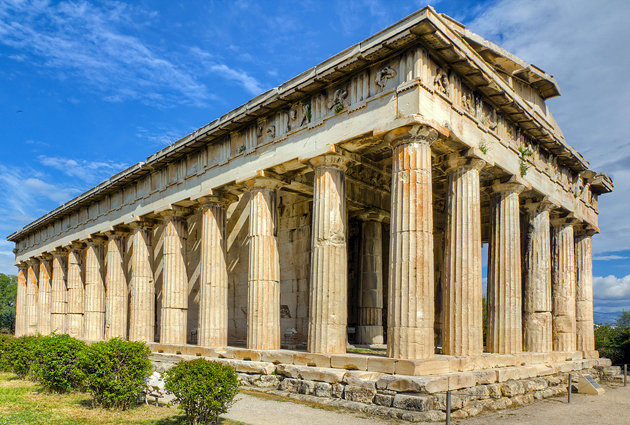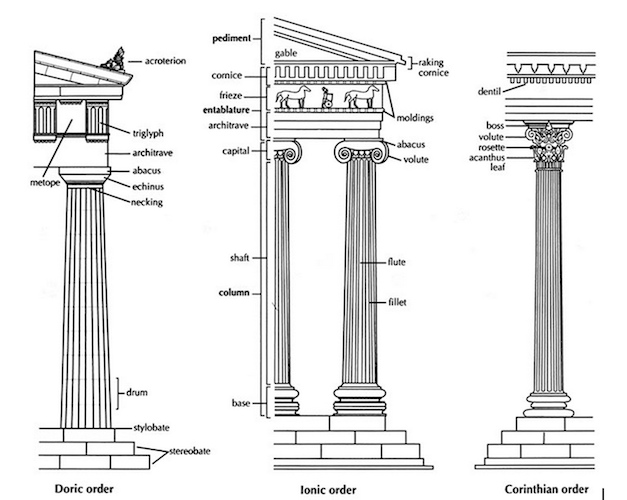We're doing a bit of a 101 post today, namely on Hellenic architectural orders. Why? Because they give you clues about the age and location of temples and other buildings, help you build timelines within architecture and knowing about these makes you look way cool at a museum which houses ancient art. Not unimportant, I would say!
All in all, there are five classical architectural orders: three ancient orders of architecture—the Doric, Ionic, and Corinthian—which originated in Greece and two more—the Tuscan and the Composite—added by the Roman. I'm not going to teach you about the Roman ones so just remember that the Tuscan is simpler than Doric and the Composite is more ornamental than the Corinthian. The Romans also had their own versions of the Hellenic orders, but we won't go into those either.
The basics on architectural orders: an order in architecture is a certain assemblage of parts subject to uniform established proportions, regulated by the office that each part has to perform. The architectural orders are the ancient styles of classical architecture, each distinguished by its proportions and characteristic profiles and details, and most readily recognizable by the type of column employed.
Each style has distinctive capitals at the top of columns and horizontal entablatures which it supports, while the rest of the building does not in itself vary between the orders. The column shaft and base also varies with the order. The capital rests on the shaft. It has a load-bearing function, which concentrates the weight of the entablature on the supportive column, but it primarily serves an aesthetic purpose. The necking is the continuation of the shaft, but is visually separated by one or many grooves. The echinus lies atop the necking. It is a circular block that bulges outwards towards the top to support the abacus, which is a square or shaped block that in turn supports the entablature. The entablature consists of three horizontal layers, all of which are visually separated from each other using moldings or bands. Those are a lot fo terms, I know. Click on the image above for a visual representation within the three styles.
The Doric order is sometimes considered the earliest order, but there is no evidence to support this. Rather, the Doric and Ionic orders seem to have appeared at around the same time, the Ionic in eastern Greece and the Doric in the west and mainland. Both the Doric and the Ionic order appear to have originated in wood.
The Doric Order
 The Doric order is characterized by a plain, unadorned column capital and a column that rests directly on the stylobate of the temple without a base. The Doric entablature includes a frieze composed of trigylphs—vertical plaques with three divisions—and metopes—square spaces for either painted or sculpted decoration. The columns are fluted and are of sturdy, if not stocky, proportions. An example is the temple of the Delians on Delos, pictured to the side.
The Doric order is characterized by a plain, unadorned column capital and a column that rests directly on the stylobate of the temple without a base. The Doric entablature includes a frieze composed of trigylphs—vertical plaques with three divisions—and metopes—square spaces for either painted or sculpted decoration. The columns are fluted and are of sturdy, if not stocky, proportions. An example is the temple of the Delians on Delos, pictured to the side.
The Doric order emerged on the Hellenic mainland during the course of the late seventh century BC. It remained the predominant order for Hellenic temple construction through the early fifth century BC, although notable buildings built later in the the Classical period—especially the canonical Parthenon in Athens—still employed it.
The Ionic order
The Ionic order originated in Ionia, a coastal region of central Anatolia (what is now known as Turkey) where a number of ancient Hellenic settlements were located. It is distinguished by slender, fluted pillars with a large base and two opposed volutes (also called scrolls) in the echinus of the capital. The echinus itself is decorated with an egg-and-dart motif. The Ionic shaft comes with four more flutes than the Doric counterpart (totalling 24). The Ionic base has two convex moldings called tori which are separated by a scotia. The Ionic order is also marked by an entasis, a curved tapering in the column shaft. A column of the ionic order is nine times its lower diameter. The shaft itself is eight diameters high. The architrave of the entablature commonly consists of three stepped bands (fasciae). The frieze comes without the Doric triglyph and metope butsometimes comes with a continuous ornament such as carved figures instead.
The Ionic order developed during the mid-sixth century BC and had been transmitted to mainland Greece by the fifth century BC. The basic structure of the Ionic order can be found in the Temple of Athena Nike at the Acropolis of Athens.
The Corinthian order
The Corinthian order is both the latest and the most elaborate of the Classical orders of architecture. As the name suggests, the origins of the order were connected in antiquity with the Hellenic city-state of Corinth, where, according to the architectural writer Vitruvius, the sculptor Callimachus drew a set of acanthus leaves surrounding a votive basket. The defining element of the Corinthian order is its elaborate, carved capital, which incorporates even more vegetal elements than the Ionic order does. The stylized, carved leaves of an acanthus plant grow around the capital, generally terminating just below the abacus.
The oldest known building built according to this order is the Choragic Monument of Lysicrates in Athens, constructed from 335 to 334 BC. Perhaps the best known Corinthian capital comes from the Temple of Apollo Epicurius at Bassae and dates to c. 427 BC.
All in all, there are five classical architectural orders: three ancient orders of architecture—the Doric, Ionic, and Corinthian—which originated in Greece and two more—the Tuscan and the Composite—added by the Roman. I'm not going to teach you about the Roman ones so just remember that the Tuscan is simpler than Doric and the Composite is more ornamental than the Corinthian. The Romans also had their own versions of the Hellenic orders, but we won't go into those either.
The basics on architectural orders: an order in architecture is a certain assemblage of parts subject to uniform established proportions, regulated by the office that each part has to perform. The architectural orders are the ancient styles of classical architecture, each distinguished by its proportions and characteristic profiles and details, and most readily recognizable by the type of column employed.
Each style has distinctive capitals at the top of columns and horizontal entablatures which it supports, while the rest of the building does not in itself vary between the orders. The column shaft and base also varies with the order. The capital rests on the shaft. It has a load-bearing function, which concentrates the weight of the entablature on the supportive column, but it primarily serves an aesthetic purpose. The necking is the continuation of the shaft, but is visually separated by one or many grooves. The echinus lies atop the necking. It is a circular block that bulges outwards towards the top to support the abacus, which is a square or shaped block that in turn supports the entablature. The entablature consists of three horizontal layers, all of which are visually separated from each other using moldings or bands. Those are a lot fo terms, I know. Click on the image above for a visual representation within the three styles.
The Doric order is sometimes considered the earliest order, but there is no evidence to support this. Rather, the Doric and Ionic orders seem to have appeared at around the same time, the Ionic in eastern Greece and the Doric in the west and mainland. Both the Doric and the Ionic order appear to have originated in wood.
The Doric Order
 The Doric order is characterized by a plain, unadorned column capital and a column that rests directly on the stylobate of the temple without a base. The Doric entablature includes a frieze composed of trigylphs—vertical plaques with three divisions—and metopes—square spaces for either painted or sculpted decoration. The columns are fluted and are of sturdy, if not stocky, proportions. An example is the temple of the Delians on Delos, pictured to the side.
The Doric order is characterized by a plain, unadorned column capital and a column that rests directly on the stylobate of the temple without a base. The Doric entablature includes a frieze composed of trigylphs—vertical plaques with three divisions—and metopes—square spaces for either painted or sculpted decoration. The columns are fluted and are of sturdy, if not stocky, proportions. An example is the temple of the Delians on Delos, pictured to the side.The Doric order emerged on the Hellenic mainland during the course of the late seventh century BC. It remained the predominant order for Hellenic temple construction through the early fifth century BC, although notable buildings built later in the the Classical period—especially the canonical Parthenon in Athens—still employed it.
The Ionic order
The Ionic order originated in Ionia, a coastal region of central Anatolia (what is now known as Turkey) where a number of ancient Hellenic settlements were located. It is distinguished by slender, fluted pillars with a large base and two opposed volutes (also called scrolls) in the echinus of the capital. The echinus itself is decorated with an egg-and-dart motif. The Ionic shaft comes with four more flutes than the Doric counterpart (totalling 24). The Ionic base has two convex moldings called tori which are separated by a scotia. The Ionic order is also marked by an entasis, a curved tapering in the column shaft. A column of the ionic order is nine times its lower diameter. The shaft itself is eight diameters high. The architrave of the entablature commonly consists of three stepped bands (fasciae). The frieze comes without the Doric triglyph and metope butsometimes comes with a continuous ornament such as carved figures instead.
The Ionic order developed during the mid-sixth century BC and had been transmitted to mainland Greece by the fifth century BC. The basic structure of the Ionic order can be found in the Temple of Athena Nike at the Acropolis of Athens.
The Corinthian order
The Corinthian order is both the latest and the most elaborate of the Classical orders of architecture. As the name suggests, the origins of the order were connected in antiquity with the Hellenic city-state of Corinth, where, according to the architectural writer Vitruvius, the sculptor Callimachus drew a set of acanthus leaves surrounding a votive basket. The defining element of the Corinthian order is its elaborate, carved capital, which incorporates even more vegetal elements than the Ionic order does. The stylized, carved leaves of an acanthus plant grow around the capital, generally terminating just below the abacus.
The oldest known building built according to this order is the Choragic Monument of Lysicrates in Athens, constructed from 335 to 334 BC. Perhaps the best known Corinthian capital comes from the Temple of Apollo Epicurius at Bassae and dates to c. 427 BC.



.jpg)
No comments:
Post a Comment